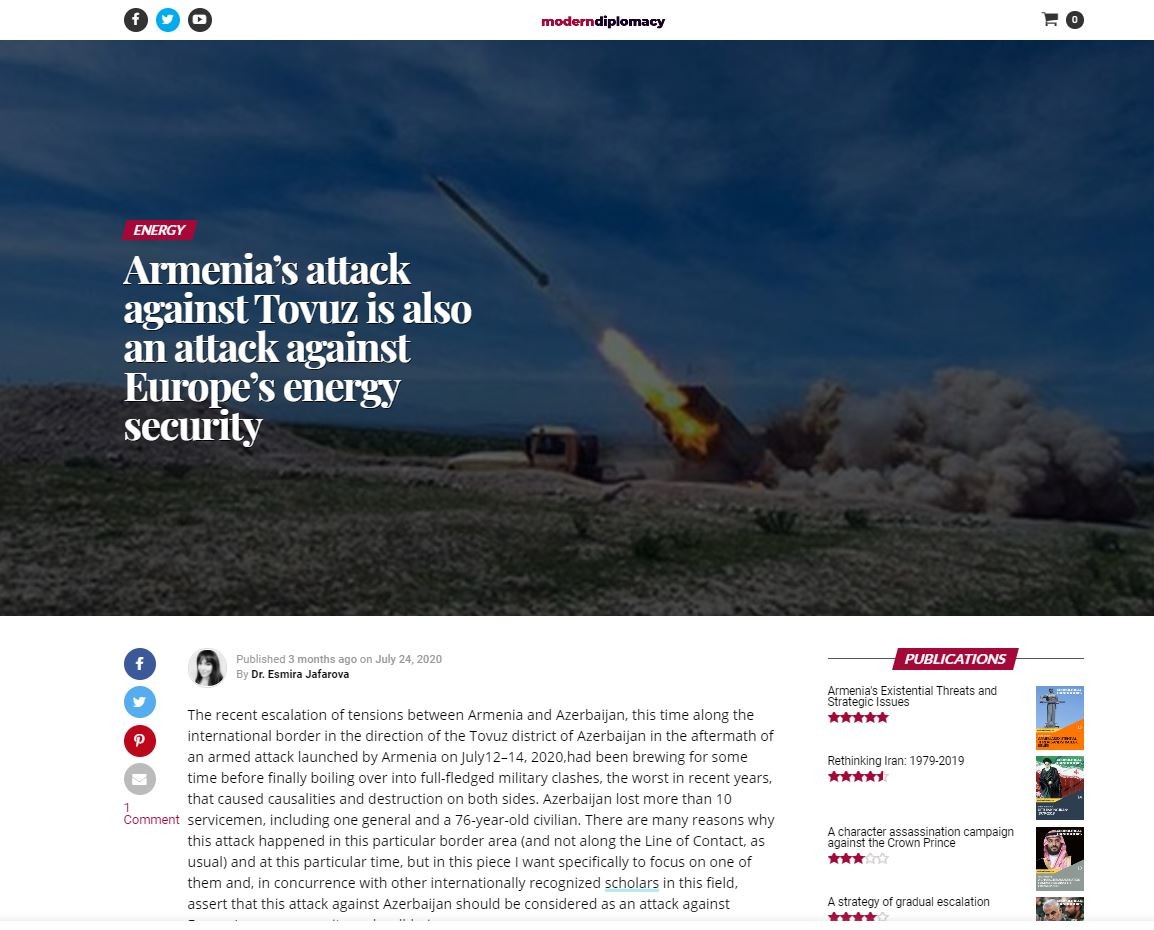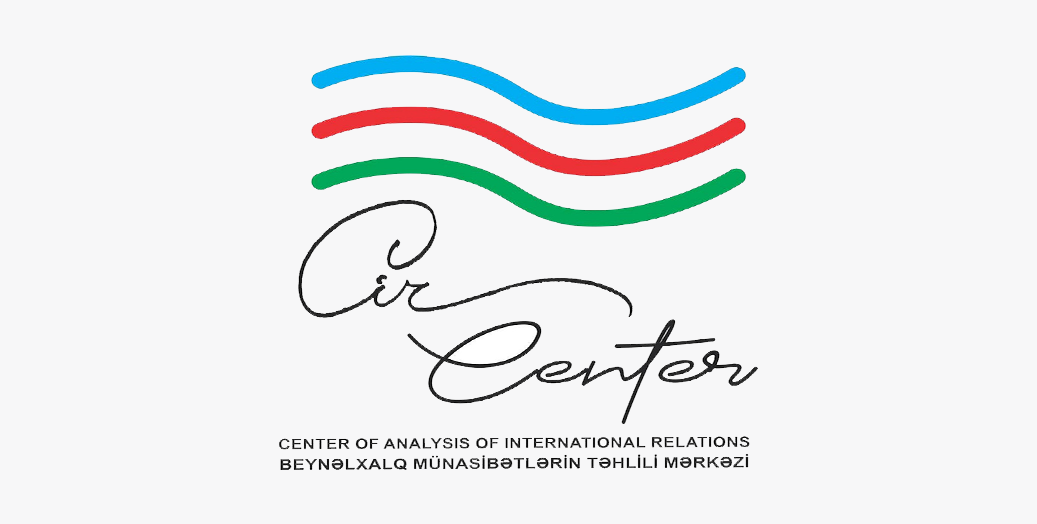The recent escalation of tensions between Armenia and Azerbaijan, this time along the international border in the direction of the Tovuz district of Azerbaijan in the aftermath of an armed attack launched by Armenia on July12–14, 2020,had been brewing for some time before finally boiling over into full-fledged military clashes, the worst in recent years, that caused causalities and destruction on both sides. Azerbaijan lost more than 10 servicemen, including one general and a 76-year-old civilian. There are many reasons why this attack happened in this particular border area (and not along the Line of Contact, as usual) and at this particular time, but in this piece I want specifically to focus on one of them and, in concurrence with other internationally recognized scholars in this field, assert that this attack against Azerbaijan should be considered as an attack against Europe’s energy security and well-being.
To begin, a brief review of the history of recent developments in conflict resolution testifies that, although the year 2019 was relatively incident free along the Line of Contact between the Armed Forces of Armenia and Azerbaijan, and for the first time in many years mutual visits of journalists took pace, the year was also identified as the “lost year for the conflict settlement” owing to the lack of progress in the negotiations. This absence of progress was accompanied by incendiary rhetoric employed by Armenia’s Prime Minister Nikol Pashinyan who, having ascended to power on the back of the many alluring promises of the so-called “Velvet Revolution,” found himself grappling to deliver on those ambitious reform pledges. The harbingers of heightening hostility were seen in Pashinyan’s infamous declaration during the pan-Armenian games held in Khankendi on August 5,2019, when he said that “Nagorno-Karabakh is Armenia, and that is all;” as well as his continuous insistence on changing the negotiation format –already established by the relevant decisions of the OSCE –to include representatives of the puppet regime in the occupied Nagorno-Karabakh region as an independent party to the peace negotiations.
The year 2020 started off with the January meeting of the Foreign Ministers in Geneva, and in April and June two virtual meetings were held because of COVID-19 lockdowns; however, hopes for any positive progress quickly subsided in the wake of other negative developments. The so-called “parliamentary and presidential elections” that were held by Armenia in the occupied Nagorno-Karabakh region of Azerbaijan on March31, 2020, were condemned by the international community. These mock elections later culminated in the Shusha provocation,in which the “newly elected president” of the puppet regime in the occupied territories of Azerbaijan was “inaugurated” in Shusha – a city that carries great moral significance for Azerbaijan. The last straw in a hostile build-up was the denial by Pashinyan of Russia’s Foreign Minister Sergei Lavrov’s comments about a staged, step-by-step solution to the conflict; Pashinyan denied that this was ever the subject of negotiations. The very recent threats by the Armenian Ministry of Defense, which publicly threatened “to occupy new advantageous positions” in Azerbaijan, further testified to the increasingly militaristic mood among Armenia’s upper echelons.
This litany of discouraging events relating to the peace process over the last year and a half in some ways heralded what we witnessed on July12–14, 2020.This attack against Azerbaijan along the international border between Armenia and Azerbaijan reflects the deep frustration of the Pashinyan regime in its inability to bring about the promised changes. Economic problems were heightened by the COVID-19-induced challenge and decreasing foreign assistance, and this was all happening against the backdrop of Azerbaijan’s increasing successes domestically, economically and internationally. Azerbaijan has long been established as an important provider of energy security and sustainable development for Europe through the energy projects that it is implementing together with its international partners. The Baku–Tbilisi–Supsa Western Export (1998) and Baku–Tbilisi–Ceyhan (2005) oil pipelines and Baku–Tbilisi–Erzurum (2006) gas pipeline have enhanced Azerbaijan’s role as an energy producing and exporting country, and the Southern Gas Corridor (SGC) is already becoming a reality. This 3500-km-long Corridor comprises four segments – the Shah Deniz-II project, Southern Caucasus Pipeline Extension (SCPX), Trans Anatolian Pipeline (TANAP) and its final portion, the Trans Adriatic Pipeline (TAP). The Corridor passes through seven countries – Azerbaijan, Georgia, Turkey, Bulgaria, Greece, Albania and Italy – with Italy being the final destination receiving Caspian gas. Turkey is already receiving gas via TANAP and is contracted to accept up to 6 billion cubic meters of gas via this pipeline. Europe is expected to receive 10 billion cubic meters of Azerbaijani gas per year, and the first gas has already arrived on Albanian territory. The SGC is scheduled to be fully operational by fall 2020 and TAP is almost complete. Things are progressing uninhibitedly and even the COVID-19 pandemic has been unable topreventthe success of the SGC. This Corridor stands as one of the guarantors of Europe’s energy security by providing diversification of energy sources and routes, even despite Europe’s Green Deal, which also acknowledges the continent’s long-term demand for gas.
Such critical infrastructure, vital for Europe’s energy security, passes close to the border area that includes the Tovuz district attacked by the Armed Forces of the Republic of Armenia on July12–14. Armenia is the only country in the South Caucasus that is isolated from these regional energy projects owing to its policy of expansion and occupation. It is thus the only country that does not have anything to losefrom creating chaos and destruction around this critical energy infrastructure. Jealousy and the feeling of self-imposed isolation from all regional cooperation initiatives have no doubt increased Armenia’s hostility toward these energy projects. Further vivid evidence of Armenia’s belligerence against Azerbaijan’s energy infrastructure was provided by its threat to attack the Mingachevir Dam, a civilian infrastructure project that is also a vital component of Azerbaijan’s largest hydroelectric power plant. Hydroelectric power comprises the largest component in Azerbaijan’s renewable energy potential, today standing at around 17–18%ofthe overall energy balance of the country. It is not difficult to imagine the magnitude of civilian causalities in case such a destruction materializes.
By conducting this act of aggression against Azerbaijan along the international border in the direction of Tovuz, Armenia wanted firstly, to divert attention from its own internal problems. Secondly, the regime desired to disguise its failures on the international front, especially recently when Azerbaijan initiated the summoning of a special session of the United Nations General Assembly related to COVID-19,convened on July 10, that was supported by more than 130 members of the UN. Thirdly, Armenia wanted to drag in the Collective Security Treaty Organization (CSTO) against Azerbaijan by invoking Article 4, which states: “… if one of the States Parties is subjected to aggression by any state or group of states, then this will be considered as aggression against all States Parties to this Treaty…”.Fourthly, and the central thesis of this article, Armenia intended to target critical energy infrastructure implemented by Azerbaijan and its international partners, thereby jeopardizing the energy security of not only the neighboring region, but also of the greater European continent. The aforementioned existing oil and gas infrastructure aside, the SGC is set to be fully operational by fall 2020, and this multibillion-dollar megaproject offers economic, social and many other benefits to all participating countries involved in the construction and implementation of this project. Any damage to this critical infrastructure would deal a heavy blow to the current and future sustainable development of Europe.
Europe must therefore be vigilant regarding such provocations. International actors, including the European Union,OSCE Minsk Group, United Nations, United States, and the Russian Federation, called for an immediate cessation of hostilities between Armenia and Azerbaijan. However, given what is at stake,including this time the crucial energy infrastructure, had Armenia’sattack not been proportionately parried by the Azerbaijani Armed Forces, the statement made by the European Union about this recent military attack could have contained stronger language beyond just “…urging both sides to stop the armed confrontation, refrain from action and rhetoric that provoke tension, and undertake immediate measures to prevent further escalation… .” Naming and shaming the aggressor appropriately is indispensable in this situation. As Mr. Hikmat Hajiyev, Head of Foreign Policy Department of the Presidential Administration and Adviser to the President of the Republic of Azerbaijan on Foreign Affairs, also noted: “the EU should distinguish between the aggressor and the subject of aggression.”
In the 21st century, the international community should not tolerate such flagrant violations of international law; disrespect of UN Security Council resolutions (822, 853, 874, and 884) and other relevant international documents calling for an end to the occupation of Azerbaijani territories; and the feeling of impunity in instigating an attack against a sovereign state, a neighbor, and a crucial player in the realization of critical energy infrastructure projects key to Europe’s own energy security. Azerbaijan has long put up with such aggression and the occupation of its internationally recognized territories in Nagorno-Karabakh region and seven adjacent districts, and has opted for negotiations toward a peaceful solution of the conflict. Yet the aggressor cannot be allowed to continue its attacks against other parts of Azerbaijan– this time Tovuz –thereby jeopardizing not only the latter, but also energy security and sustainable development of the greater European continent just because such provocations seem to offer an escape from the regime’s domestic and external problems. Such practices should be condemned in the strongest possible terms. This should be done not only for the sake of Azerbaijan and regional security in the South Caucasus, but in the name of Europe’s own energy security and well-being.







